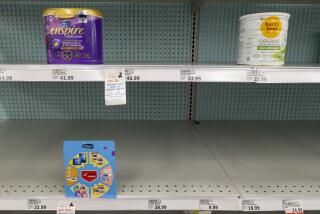OSHA Plans Safety Checks of Semiconductor Industry
- Share via
The U.S. Occupational Safety and Health Administration announced Wednesday that it is launching a special pilot inspection program to evaluate job safety protection programs in California’s semiconductor manufacturing industry.
OSHA spokesman Joe Kirkbride said such a pilot inspection program is “unique in the nation.”
Frank Strasheim, OSHA regional administrator in San Francisco, said the semiconductor industry “is generally considered to be very safe and has one of the lowest worker injury rates.” However, he said, “OSHA has significant concerns about the potential for employees’ exposure to the many hazardous substances in the manufacturing process.”
“We want to make sure employers have the proper safeguards in place to protect the safety and health of their workers, particularly when significant quantities of hazardous substances are involved,” Strasheim added.
He said OSHA’s San Jose area office would be the “most involved” in the special inspection program because the semiconductor industry is centered in Silicon Valley. But he noted that there are also a number of manufacturers in the Los Angeles, San Diego and Sacramento areas.
Jeanne Louck, a spokeswoman for the Semiconductor Industry Assn., said there are about 60,000 workers at 110 companies in the industry in California.
Strasheim’s statement indicated that OSHA’s decision to launch the special program was precipitated by an incident in Silicon Valley last month “when more than 1,000 workers were unable to work and business firms shut their doors for several days because potentially dangerous gas cylinders were discovered at three plants. . . .
“The cylinders, filled with silane gas widely used in the semiconductor industry in small quantities to coat silicon wafers in processing microchips, were linked to an explosion in New Jersey that killed three people,” Strasheim said.
On March 23, a week after the New Jersey incident, Liquid Carbonics Specialty Gas Corp., a Chicago-based company with a plant in San Carlos, took about 30 of the cylinders to a disposal site near San Francisco and exploded them. More than 200 people were evacuated from their homes during the procedure.
Lee Neal, director of safety, health and environmental affairs for the Semiconductor Industry Assn., said he had “no problem” with the OSHA program. “We don’t see it as confrontational. . . . The semiconductor industry has an excellent safety and health record.”
‘Serious Problem’
Ted Smith, executive director of the Silicon Valley Toxics Coalition, said, “I’m glad somebody is finally paying attention to the serious problem of toxic gas usage in the electronics industry.” However, he added, “I’d be very surprised if federal OSHA knew enough about what to look for to be effective.”
Smith said that for the last two years the Santa Clara County Fire Chief’s Assn. “has been trying to get much stricter controls on toxic gases.” He said he hopes OSHA’s inspection program will assist the association’s efforts.
Smith also said a study done by the UC Davis Medical School last August showed that there was reason to question OSHA’s assumption that the industry is safe. The study said that the industry’s occupational health reporting system did not “completely or consistently record occupational illnesses with subtle manifestations or long latencies.”
To Start Immediately
The OSHA program is scheduled to begin immediately and continue through Sept. 30. All companies with 11 or more employees involved in the fabrication of semiconductor materials will be subject to inspections.
The OSHA evaluation will focus on four aspects of an employer’s safety management program: employee training, maintenance, emergency reaction and design and control. In particular, inspectors will look at whether hazardous materials are handled according to recognized procedures, whether continuous monitors are present to warn employees of any leakage of hazardous materials and to minimize potential exposure. And inspectors are supposed to check on the types, amounts and concentrations of hazardous materials used.






